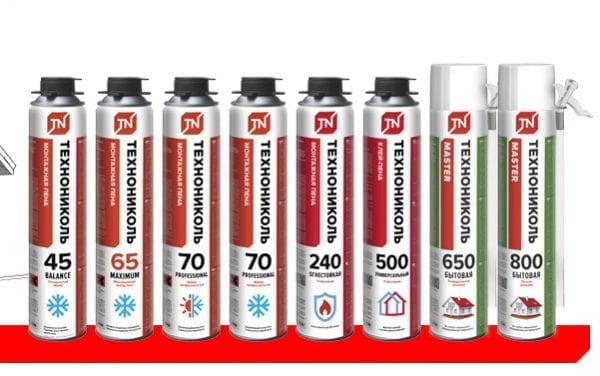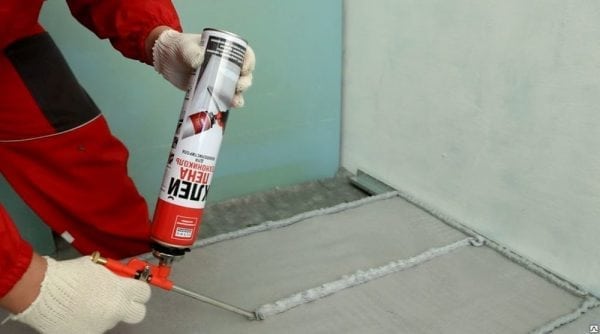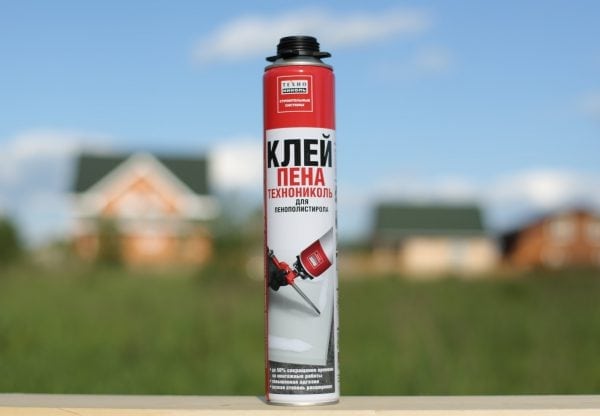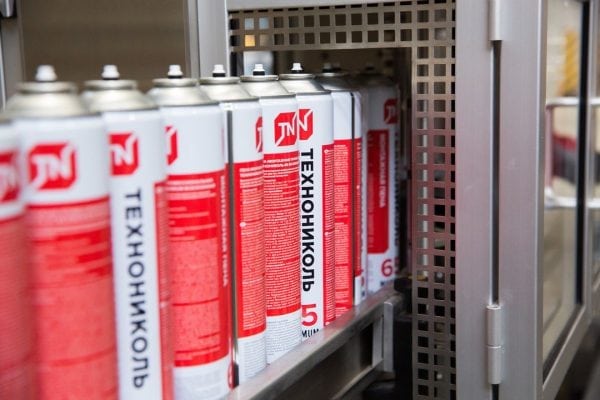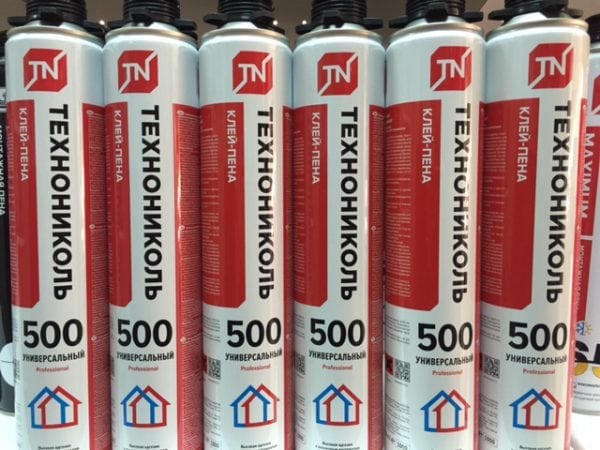Many people use mounting foams and adhesives during repairs without thinking about the price-quality ratio. It is worth taking a closer look at the products under the TechnoNIKOL brand - it will please with efficiency and moderate cost. For example, TechnoNIKOL 500 Professional universal adhesive foam has long been present on the construction market and respected by professionals.
- Types of glue-foam
- TechnoNIKOL 500 Professional - universal adhesive foam
- TechnoNIKOL for expanded polystyrene
- Advantages and disadvantages
- Instructions for use
- Adhesive Foam Consumption
- Safety, packaging and storage
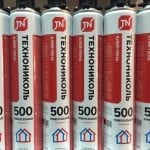
Types of glue-foam
Glue-foam of this brand is a one-component polyurethane adhesive. It allows you to mount products from extruded polystyrene foam and conventional polystyrene. The composition of the material is represented by various target additives, and oligomers of isocyanates play the main role in it. They are able to actively displace propane, isobutane during the reaction with oxygen from the surrounding air. The distinctive properties of glue-foam are as follows:
- providing good thermal insulation;
- reliable fixation with the base;
- resistance to mold, moisture;
- excellent wear resistance and long service life.
The insulating and adhesive qualities of the adhesive foam are at a high level. This allows the use of a means for attaching polystyrene foam to concrete, brick, wooden walls and other substrates. It is widely used in works with drywall, aerated concrete, gypsum fiber, magnesium glass sheet. There are two main types of TechnoNIKOL for expanded polystyrene, they are described below. Each product is sold in cylinders of 400, 750, 1000 ml.
to contents ↑TechnoNIKOL 500 Professional - universal adhesive foam
This product is the most popular in the series, it has excellent strength of binding components and high adhesion to any surface. It is widely used for XPS (extruded polystyrene foam), including thermal insulation boards made of this material. Also, foam can seal joints between the plates during the installation of insulation:
- roofing;
- foundation;
- basement;
- basement floor;
- outside the house;
- inside the house and apartment.
Glue-foam is suitable for filling cracks in the walls, fixing plastic, sheet metal, panels, drywall, mineral wool. Glue will fill any voids, cavities. It can also be used to glue tiles on the roof, decorative elements - skirting boards, cladding, stucco molding. A universal tool suitable for all types of substrates listed above, as well as for plaster, chipboard, tile, porcelain stoneware.
The technical parameters of TechnoNIKOL foam are as follows:
- thermal conductivity - 0.035 W / mk;
- setting time with the base - 10 minutes;
- final drying - 24 hours;
- the density of the finished adhesive layer is 25 g / cu. cm;
- the hue of the foam after hardening is blue;
- temperature during work - from 0 to +35 degrees;
- recommended humidity when gluing boards - up to 55%;
- adhesion to extruded polystyrene foam - 0.13 MPa, concrete and wood - 0.15 MPa, metal - 0.07 MPa.
During the first ten minutes, you can change the position of the glued plate, which is ideal for beginners.
to contents ↑TechnoNIKOL for expanded polystyrene
This material is designed for gluing polystyrene boards, perfectly suitable for arranging thermal insulation. The composition introduced polyurethane, which tends to increase in size by 10%. Using this glue-foam, it is possible to fix polystyrene foam on buildings from the outside and from the inside, insulate basements and the foundation. It closes the joints between the plates, eliminates pits and voids.
Technical parameters of the product are similar, the difference in the period of initial setting. It is slightly larger than universal glue (15 minutes). It differs in the color of the finished layer (gray). If necessary, you can use TechnoNIKOL for expanded polystyrene and for fixing other materials, but the manufacturer recommends using it for its intended purpose.
to contents ↑Advantages and disadvantages
Specially developed means of properties always surpass conventional tile adhesives. In the case of TechnoNIKOL glue-foam, this rule is also observed. Using it has a lot of advantages:
- ease of use - the finished composition does not need to be bred, it is easily squeezed out of the cylinder;
- shortening the time for installation work - achieved thanks to the convenience and quick setting;
- the presence of a small but sufficient time to clarify the location of the plate;
- the ability to seal joints and crevices without buying any other means;
- the absence of "cold bridges" due to the similar thermal conductivity as that of the glued material;
- 100% reliability of fastening, high quality grip with any base;
- resistance to moisture, mold - no additional antifungal treatment;
- suitability for indoor and outdoor use.
to contents ↑Only a higher price can be added to the minuses than that of cheap glue for tiles, although Technonikol often wins in comparison with analogues. Also, you can not use foam at low temperatures, you have to wait for the warm season.
Instructions for use
How to apply glue foam? The instructions are the same for the entire line of tools. As a preparation, you need to make the surface absolutely dry, clean, without dirt and debris - this will increase adhesion. The base is wiped or washed, dried. To apply glue, use a mounting gun or directly a cylinder. The second option is much more convenient, reduces foam consumption.
How to glue polystyrene boards? The correct procedure is as follows:
- put the bottle on a flat surface with the valve up;
- remove the protection cap, connect the cylinder to the appropriate place in the mounting gun;
- shake the can;
- apply glue to the plate around the perimeter, slightly departing from the edge (glue strips should be no thicker than 3 cm);
- apply glue in the center of the plate with a strip from top to bottom;
- wait 5 minutes, attach the plate to the base (when moving from the wall do not tear off);
- press the expanded polystyrene, fix it in the right position, leave it until the glue sets;
- repeat work, leaving cracks between tiles of 3 mm;
- after drying, apply glue-foam to fill the cracks;
- after a day, cut out the foam with a knife, stains of glue can be removed with a special cleaner of the same brand.
to contents ↑
Adhesive Foam Consumption
Usually 1000 ml is enough for 10-12 square meters. m surface provided that the application method described above. A 750 ml cylinder should be purchased for 8-10 square meters. m, 400 ml - per 4 square meters. m. In terms of cost, large packages are usually cheaper, for 400 ml you will have to pay 200-250 rubles, for 750-1000 ml - about 300-350 rubles.
Safety, packaging and storage
Keep TechnoNIKOL glue-foam in a dry room, air temperature is above 0 degrees (up to +35). As a temporary measure, freezing up to -20 degrees is possible for an hour. Longer exposure to cold makes the product unsuitable for use. Cylinders must be stored vertically, horizontal storage is not allowed. Shelf life is 1 year.
For safety, the presence of nearby open flame sources (during operation or storage) must not be allowed.When buying, it is important to ensure the integrity of the container and the availability of certificates of conformity.

